14 th. July 2010.
Why does it have to get so bright, so early in the mountains? Wake up at 5.30 am., again and see the day dawning at this unearthly hour. (By Bombay standards!) I decide not to get out of the bed and sleep for some more time. It's nice and warm under the covers. Shut my eyes and wake up after some time, hoping that it would be around 6.30 am. at least. No such luck, its only 5.45 am.! Maybe I need to rise and shine! Getting to be a bad habit, this waking up early! Get up, brush my teeth and step out of the room, hoping to find someone from the hotel staff, to make me a cup of tea. No such luck. All the doors are shut and there is no one near the kitchen too. Looks like tea is out of the question anytime soon.
Arshad and Dinesh are still in their dream world. Decide against waking them up. The schedule for the day is not too hectic. So may be they can sleep for some more time. Knowing Arshad, he would want his tea as soon as he is awake. That is not going to be a possibility, as there is nobody around, whom I can ask for tea! I decide to take a bath and get ready. Thankfully there is hot water, so I have a bath and shave too! By the time I come out of the bathroom, I see that Dinesh is up, while Arshad is stirring and about to wake up some time soon. Its almost 7.00 am. I step out of the room again and finally see a staff member of the hotel. I immediately ask him to send teas to our room.
Mission accomplished, I head to the car, to check vitals, oil level, coolant level, tyre pressure, etc. I open the rear door, to be greeted by the heavy smell of Diesel. Has there been a leakage? I check the Jerry cans and sure enough one of them has got a hairline crack. I remember one of the cans had fallen on the way to Chandratal. We tied the two cans together after that, but the crack must have happened when one of them fell. The can is not as sturdy as it looks. Will need to talk to the manufacturer once we get back to Bombay. Decide to empty the contents of the leaking can into the diesel tank, before leaving. Head back to the room to tell the guys about the can.
The tea has already come, while I was checking the car. Dinesh is ready having taken a bath and Arshad is getting ready. I tell them about the leaking can. We need to discuss the plans for the day. The destination for the night will be Nako. We will be heading in the opposite direction first to visit Kibber village and Kye Monastery. The attendant comes and asks us what we would like for breakfast. Unanimous decision to have bread and omelette. Pack all our stuff into the bags and take it down to the car. Before putting the luggage into the car, we decide to empty the fuel out of the leaking can into the tank. Its a tough job, with two people lifting the can and one person holding the funnel. (Next time I will carry 4 plastic cans of 10 lts. each.)
The attendant comes to tell us that, breakfast is ready. We go to the restaurant and have our breakfast and teas. Time to settle our bill. Our stay at this place has been really wonderful. Small Hotel, but nice and cozy. Would definitely recommend it to future visitors! Say our goodbyes to the hotel staff with a promise to return sometime in the future, go back to the room, to do a final check and make sure that we haven't left anything behind. It's 8.45 am. when we finally leave the hotel.
Head out of Kaza, towards Rangrik and at the Rangrik Bridge keep going straight towards Kye and Kibber. A little further down, we stop to take a few photos of Kye monastery in the distance.
Move on towards Kibber and the road is now climbing, with lots of twists and turns. Surprisingly the condition of the road is very good. We reach the village of Kibber at 9.30 am. It's approximately 19 kms. from Kaza. The village is situated at a height of 4270 mts above MSL. Till some time back, it was said to be the highest permanently inhabited, motorable and electrified village in the world. I am told, that as of now there is some confusion regarding this status and it is either Gete or Komic at around 4275 mts. above MSL. (some say its 4500 mts.) in Himachal Pradesh or LaRinconada in Southern Peru at an altitude of 5100 mts above MSL. (To be verified) Kibber has a monastery and the Kibber Wildlife Sanctuary.
After a halt of around 20 mins., we move on towards Kye Monastery. Kye Monastery is the biggest in Spiti valley and is a religious training centre for Lamas. The walls of the monastery are covered by paintings and murals. It also has a collection of ancient murals and books of high aesthetic value and it enshrines Buddha images & idols in the Dhyana position. It has three floors, one of the rooms called Tangyur, is painted with murals. The Assembly Hall and the monks' cells are on the ground floor. Unfortunately we are prohibited from taking photographs of the Hall and the rooms.
After spending about 40 mins. at the monastery, we head back towards Kaza and reach at around 11.30 am. We decide to go to the Kaza market, to shop for some mementos, make calls to Bombay, etc. After finishing shopping, Dinesh and me decide to have Filter coffee at the German Bakery in the market. At Rs 40/= a cup, it is expensive, but we have it anyway. Take a look at the watch and realise that we have spent nearly 55 mins., in the market and decide to leave for Dhankar Monastery our next destination immediately.
We drive past the villages of Shego, Lidang, Attargu. At Attargu is the turn off for Pin Valley. Just after the village of Lingti, we are forced to halt in our tracks, for this ...........


It reminded me of the countless times I had seen Wildebeest rushing down mountains to cross rivers on National Geographic and Discovery Channels. But this was live in front of my eyes and they were just sheep and goats. Awesome spectacle nonetheless! Waited for nearly 10 mins. till all the animals had crossed over and then proceeded. Past the village of Lingti, reach the Dhankar turn off at 1.10 pm. and 20 mins later after a steep ascent we are near Dhankar village. We stop to take a few pictures.










Dhankar Monastery is situated at an elevation of 3894 mts. above MSL. It is built on a 300 mtr. high spur overlooking the confluence of the Spiti and Pin Rivers and is a very spectacular setting for a Gompa. It was built as a fort monastery. Dhankar was the traditional capital of the Spiti Valley Kingdom during the 17th century and was the seat of the early rulers of Spiti, the Nonos. The monastery has some features dating back to the 12th century. There is a small museum in the Gompa. It was selected as one of the 100 most endangered sites in the world in 2006 by World Monuments Fund. A nonprofit group Dhankar Initiative is attempting to organize its conservation. Again photography inside is prohibited. The Monastery is very old and in a dilapidated condition. Some parts of the monastery have been permanently closed.
The monk who shows us around, offers us a cup of tea, which we politely decline. He suggests that we should go to the new monastery, lower down in the village, and have lunch at the restaurant near by. We offer to drive him down to the new monastery. At the restaurant we order Aloo Parathas for lunch. Dinesh decides not to eat anything and orders Lemon tea for himself. After lunch and tea, we decide to move and proceed towards Tabo. Its around 2.20 pm.
We descend from Dhankar and cross the village of Sichling at 3.15pm. Drive past the villages of Poh and Kurith. Most of the villages are so small, that you may miss them if you blink your eyes. Reach the Tabo bridge at 3.53 pm. and enter Tabo town at 3.55 pm. Tabo is quite a big town, with its main attraction being the Monastery. It also has a helipad, and a government run hospital. Unfortunately we reached Tabo at a time, when most of the temples in the Monastery were closed. However we get a chance to go into The Chamber of Picture Treasures. It has lovely paintings on the walls, done by Kashmiri Artisans I am told. Again photography prohibited. The monastery includes 9 temples, including The Chamber of Picture Treasures. The Monastery itself was founded in 996 AD.
We leave the monastery after around 30 mins., heading towards Nako. Pass the village of Lari. On the outskirts of the village, is the Horse Breeding Farm run by the Department of Animal Husbandry, Himachal Pradesh. Interesting place. Maybe will try to visit it, the next time I am here! The village of Hurling passes by and we leave Spiti valley and enter Kinnaur valley. I don't know about the others, but I am already beginning to miss this place!
Reach the village of Sumdo and the Police Check Post, all the papers and details of cars and passengers checked and noted. The climb begins immediately, a very steep climb all the way to Nako, again driving only in 2nd. & 1st. gear. Pass the villages of Salkhar and Chango and finally reach the top of the climb, near the helipad. Head straight to Nako town.
Take the road past the bus stand, presuming it will lead straight to the lake. Absolutely wrong, we reach a dead end on one side and a road that leads outside town. Finally decide to ask for directions, and have to head back to the bus stand as the turn off for the lake is right next to the bus stand. Before proceeding further, we have tea at a small restaurant on the main road. (Haven't had any tea since Dhankar!)
We drive to the lake on a very narrow path. It's almost 6.30 pm. The road does not lead straight to the lake so we park at one end and decide to walk down to the banks of the lake. After having seen Chandratal yesterday, looking at the lake here is a big disappointment. Maybe we were expecting something more. Its a small lake surrounded by the village on three sides.
The light is quickly fading, Arshad and me decide head out in search of a place to stay for the night. We come across a tented campsite, very close to lake. Have a look at the place, but the charges are a little to steep, we feel! Wait for Dinesh to come back and then head back to the bus stand area. We had seen some hotels on the way to the lake. We finally settle on the Hotel Reo Purguil, just behind the bus stand. Decent place, undergoing expansion. Rooms are decent. Lots of foreign tourists, mainly from Israel. We settle into our room, but not before ordering tea for Arshad and me. We ask for the dinner menu and place our order for dinner, to be served at around 9.00 pm.
We wash up and sort of go over the day. Its been a good day of driving, visiting old Gompas and some wonderful vistas in Spiti valley. Tomorrow, we will be the last leg of the journey in Dev Bhoomi. I feel a little bit of sadness creeping into me. Always happens, when I realise that a journey is going to be ending soon. Brush off the sadness, assuring myself that we have a few more days to go before the journey actually ends.
We head to the restaurant at 9.15 pm and have a hearty meal. I realise it's pretty cold here too, as soon I step into the balcony after the meal. Head back to the room at around 10.15 pm. Time to hit the sack, but not before finalising tomorrows drive. It's decided that we should ideally leave Nako latest by 8.30 and reach Rampur before 4.00 pm. That should give us some time to get the Bolero checked at a garage in the town. If we are lucky we might even be able to have it checked at a M & M ASC! The suspension/ shock absorber issue is still a problem. On the drive to Nako, a couple of times the wheels did hit the underside. Would be better if we checked it out before heading back to Bombay. On that note, we say our good nights and as usual are out like a light!
To be continued...............................

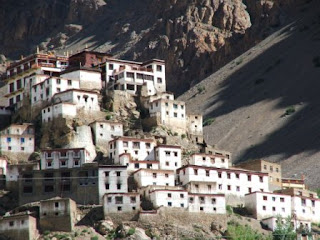


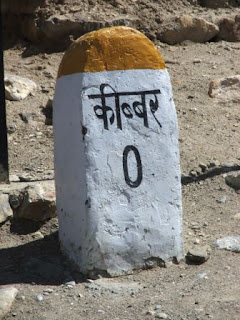










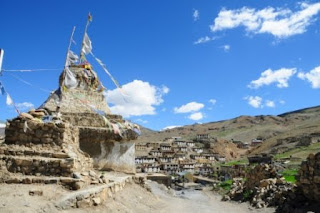











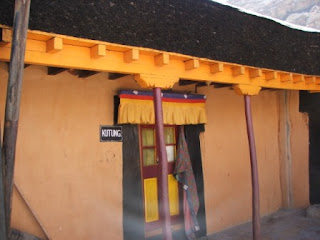





















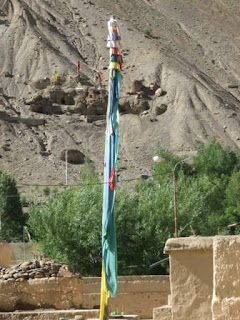












The shot of the sheep cantering across the road is simply Nat Geo stuff!
ReplyDeleteInteresting info on Khibber - temperature dips down to -35 C in the winter, but residents stay put!
Lower down, in Ke Monastery, the monks are buried under snow for 2 months a year, and they simply survive by carrying on their daily religious chores in hibernation mode. Indeed inspiring tales of human endurance and tolerance and religious piousness!
Q: Why does it have to get so bright, so early in the mountains?
ReplyDeleteA: You're a little closer to the sun, duh...
Dhankar Monastery was actually the palace of the former king and his personal monastery. the latter was opened to public after the king built another Monastery at a higher level for personal use. Monasteries are built at a high point on the mountain probably for the solitude and silence at these altitudes. (same reason why our rishis meditated at high altitudes?)
ReplyDeleteso many towns have a building order (from above downwards) of monastery (Royal), palace, monastery (public), and finally at the lowest level, town buildings
Reo Purguil is the sacred spring of Nako village. it was thought to suddenly emerge through hard rock as God's gift to the people of the region. apparently it flows all year and does not freeze up in winter!!!
ReplyDeleteyou'll probably loose a limb to frostbite trying to find an ASC (M&M or otherwise). just go into any village or army camp and ask for help and you're probably better off. these are more easily accessible in the region. or just stand by the vehicle and usually locals passing (in their vehicles) by will certainly help out as best they can.
ReplyDelete3 cheers bolero, it brought us home (actually in better shape than we had left); i think we all put on some weight (& beards & whiskers) ;-)
Why Gompas at higher altitude? Also to protect them from attacks by hostile tribes and non-Buddhist enemies. They are usually at vantage locations with a panoramic view of the valley below and usually having difficult pathways to reach?
ReplyDelete